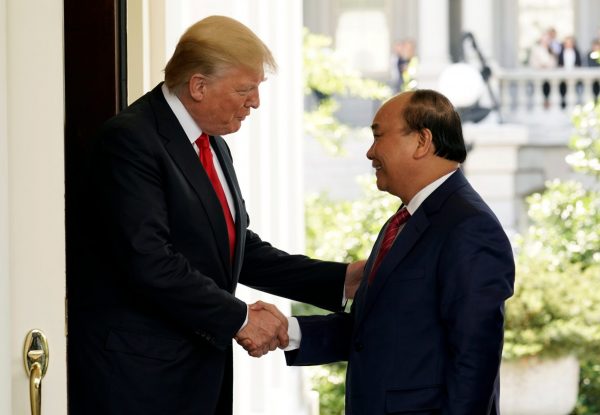Trade dominated the talks and featured heavily in the first part of the Joint Statement. Since normalisation of ties between the two former enemies two decades ago, the issue of trade has been second to none. The US trade deficit with Vietnam has risen from US$7 billion to US$32 billion in the past decade, troubling the Trump administration. But other issues are becoming increasingly important too.
Both Hanoi and Washington want to advance their naval cooperation in the face of China’s continued escalation in the South China Sea (known in Vietnam as the East Sea). After China deployed the oil rig HD-891 in Vietnam’s exclusive economic zone in 2014, Vietnam turned to the United States for protection and support in building its military strength.
Last year, the Obama administration lifted a Cold War-era ban on the sale of lethal weapons to Vietnam, creating a pathway for US weapon manufacturers to the Vietnamese market. One week prior to Phuc’s visit to Washington, the US government handed over 6 Metal Shark patrol boats and a High Endurance Hamilton-class Cutter to the Vietnamese Coast Guard. And following the meeting, a visit by a US aircraft carrier to a Vietnamese port is on the cards.
In addition to these military ties, the Joint Statement reiterated the need to enhance intelligence cooperation. During former Vietnamese prime minister Phan Van Khai’s 2005 visit to Washington, the United States and Vietnam agreed to work together in intelligence. But intelligence cooperation was absent from the agenda in the Obama-era. This latest breakthrough show-cases the increased trust between Washington and Hanoi. In the past, intelligence cooperation between Vietnam and the United States has been aimed at fighting transnational crime, cyber-attacks and terrorism, and now it is expected to be expanded to naval cooperation in relation to maritime territorial disputes.
Vietnam also used the talks to express its support for the United States to play a bigger role in the region as a ‘Pacific Power’ and continue Obama’s ‘Pivot to Asia’. On various occasions, Vietnam has called for the United States to actively engage regional issues, including territorial disputes, to prevent an assertive China from bullying smaller claimants. In response, Trump reiterated the United States’ commitment ‘to fly, sail and operate anywhere international law allows’. And the inclusion of the US government’s position on its operations in disputed maritime territories for the first time in a US–Vietnamese joint statement may foreshadow a change in their future maritime cooperation.
Another significant point in the Joint Statement is the planned upgrade of diplomatic ties between the United States and Vietnam from ‘intent to expand annual high-level dialogues between their two foreign ministries’ to ‘regular dialogue between the US Secretary of State and Vietnam’s Minister for Foreign Affairs’. The closer ties between the foreign ministers, along with the existing defence dialogue mechanisms and regular visits by defence ministers, will be a prospective frame for opening a Vietnam–US 2+2 foreign and defence ministerial strategic consultation in the future.
During the visit, Trump accepted a joint invitation from the Vietnamese president and prime minister to attend the APEC summit in Da Nang in November 2017 and make an official visit afterward, demonstrating the Trump administration’s emphasis on the importance of its relationship with Vietnam. Trump will become the first US president to visit to Vietnam in their first year in office. And, no doubt, a business-minded Trump will use this occasion to pressure Vietnam to do more to reduce the trade deficit and bring home more billion-dollar trade deals.
Trump’s visit to Vietnam is an auspicious opportunity for him and his administration to reiterate the message in the Joint Statement to US allies and other countries in the region that the United States is not pivoting away.
The agenda for US–Vietnam relations looks ambitious and may become a disappointment if issues in the relationship, such as the trade imbalance, are not properly addressed. But none of these points are insurmountable. The biggest challenge to this agenda is not any of these individual issues, but the determination of policymakers in Washington and Hanoi.
Hai Hong Nguyen is a Researcher at Queensland University of Technology.


Since when is Trump concerned about the trade deficit with Vietnam considering the fact that American corporations have controlled US government for the last 37 years with the end result that American trade barriers are lower compared to other countries, American manufacturing jobs being sent overseas, etc? Vietnam beat the American military and now they are beating us economically thanks to the US government and American corporations.
As long as Trump does not allow his myopic focus on trade deficits to overwhelm the bigger picture he could foster a much broader and deeper relationship with Vietnam, as well as its neighbors. Will he alienate APEC members as he has the EU, G7, and G20?
If Trump wants to make America great again, then he better put back in place all the things that made America a creditor nation not a debtor nation like higher tariff barriers, better trade deals, etc.